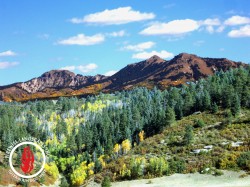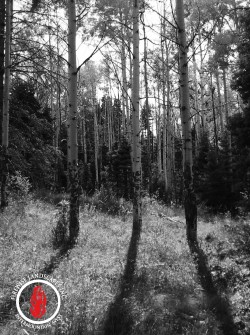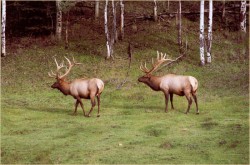by J. Thomas Gebauer, ALSA
Project Overview – Crucial Elk Migration Protection

Looking north towards the Edward Sargent Wildlife Area
The Quinlan Ranch is located on 17,000 scenic acres in northern New Mexico. The Quinlan Ranch sits along the San Juan-Southern Colorado elk herd migration route and provides crucial elk habitat.
The ranch features forests, scrub oak, meadows, scenic bluffs and mountains. The ranch abounds with wildlife including elk, black bears, mule deer, wild turkey and much more. Firewise Landscapes, Inc. was selected to restore part of the forest lands and aspen groves to optimize elk habitat and to limit the spread of the fir engraver beetle as to ensure food sources for the large animals so they can be hunted by private guides.
Why Our Services Were Needed – Optimizing Elk Habitat

Three aspens standing their ground
In the Rocky Mountains, aspen groves have been on decline. The cause of this is still being debated but many signs point to fire suppression. Quaking Aspens (Populus tremuloides) thrive on disturbed sites and are typically the first dominant emergent species after a fire. One reason for these aspens survival during a fire is the manner in which aspen form colonies. When a fire passes through an aspen stand, the trees are able to send up “clones/suckers” quickly from their root systems, ensuring that the species will survive. One instance of this happening on a large scale is the organism known as “Pando.” Pando is considered to be the heaviest living organism on Earth.
Pando: The Ultimate Aspen Grove
Pando is estimated to be 80,000 years old, weighing 6,600 tons, covering 106 acres and consisting of 47,000 stems. The stems continually die and are renewed by it’s root system. All of the 47,000 stems are genetically identical thus making it one living organism. Recently it is believed that Pando is slowly dying from a combination of considerations that include fire suppression, insects, drought, disease, livestock, and campers.
Fire Suppression Linked to the Decline of Aspen’s
In the absence of fire, other species emerge, which out-compete aspen by blocking direct sunlight. One recently documented epidemic affecting aspens is the Sudden Aspen Decline (SAD). While widely debated, SAD has been linked to drought, warm temperature, and fire suppression.
Project Scope and Certifications for the Ranch – Fire Modeling

Elk Grazing in a Meadow
By removing timbering that was hindering healthy growth of the aspen groves, Firewise was able to effectively play the role of a fire without the unpredictability of the fire. Through the regeneration of aspen stands, Firewise enhanced the abundance and diversity of vegetation for ungulates to forage. In addition, the general biodiversity index has increased significantly in areas of disturbance.
So as to successfully allow the stands to mature, temporary brush fences (stacked felled timbers) were installed by using conifer trees that were removed from the aspen stand. The brush fences prevent wildlife from eating the delicate emergent vegetation before it establishes to an acceptable level of growth. The fences will remain for approximately 7-10 years at which point they will be opened to allow wildlife to access the protected stand.
Firewise Landscapes, Inc. has executed projects on roughly 300 acres of the ranch, restoring forest health to aspen, conifer, shrub, and grassland cover types. With the guidance of Firewise and the assistance of Jose Carrillo at New Mexico State Forestry New Mexico State Forestry, the owners of the ranch applied for and received certification as an American Tree Farm by the American Tree Farm System (ATFS). The ATFS works to sustain forests, watersheds, and healthy wildlife habitats through the power of private stewardship by offering affordable forest certification for family forest landowners in the US. By registering with ATFS, the forests of the Quinlan Ranch qualify for registration with the Climate Action Reserve (CAR). The CAR provides a protocol and a marketplace for the registration and trade of carbon that is sequestered within forests.
Click Here to learn more about the forest management expertise at Firewise.


